Do you have St. Augustine? Have you felt an impending sense of doom because your St. Augustine is yellowed and browned along the edges of your lawn with discolored patches spreading into a sort of irregular pattern? If you answered yes to the previous two questions, there is a possibility you could have a chinch bug infestation taking place. And while it is no cinch to get rid of the chinch, it is possible. With some information on the pests themselves, plus tips for treatment, we can kick these bothersome pests to the curb.
(NO! Not Chinch Bugs!)
Chinch bugs, or Blissus insularis, are bothersome turf pests that have become well-known throughout the south. Since they prefer to suck the life out of St. Augustine, a highly sought after turfgrass, many San Antonio homeowners find themselves battling chinch bugs summer after summer. Chinch bugs thrive in hot temperatures and areas that receive full sunlight. They love areas of turf that are drought-stressed. And if you have laid your sod on high, sandy, or shell soil….watch out! These tiny bugs can do an immense amount of damage.
(Nymph (left), and the short-winged (center) and long-winged adult forms of the southern chinch bug, Blissus insularis Barber. Photograph by R.H. Cherry, University of Florida.)
Chinch bugs lay eggs close to the soil at the base of grass blades. The eggs hatch and these new nymphs immediately start feeding on the tender newer growth of your grass. Never ones to turn down a meal, the adults will also gather together and feed at the base of your grass. They suck out the sap at the same time injecting a poison that causes blades of grass to die down to a dry, withering brownish-yellow blade; then they move on to the next blade for more carnage. Left untreated, chinch bugs can demolish large patches of turf in a couple of weeks.
(Chinch bug damage…photo courtesy Aggie Horticulture)
You won’t see chinch bugs running rampant over the blades of your grass, but you can see them if you get down on your hands and knees. Spread apart the blades of grass on the border of damaged areas and healthy areas and check for BB sized, black insects with a kind of white diamond shape on their wings. Look in several areas of damaged turf. If no chinch bugs are present, damage could be from other possibilities like grubs, root rot, drought damage, or other issues. Full sun areas, drought-stressed areas, and over-fertilized areas tend to be like a huge welcome sign that reads, “Chinch bugs, we have vacancies, families welcome! Free buffet!”
After examining your lawn, or bringing us samples and pictures and realizing you have chinch bugs, you’ll need to take home a product containing the ingredient Imidacloprid. These are the same products that do wonders on battling grubs and have proven to be highly effective on most soil-dwelling pests. Be sure to always read all instructions to know if/when you need to reapply, and how to apply correctly.
Beneficial Nematodes are an organic option for ridding yourself of soil-dwelling pests. You can find out more about beneficial nematodes here.
July and August are prime time for chinch bugs to do their damage and it’s always best to apply any insecticide as soon as damage is noted. So get on out there with your coffee can and get on your hands and knees and give the neighbors something to talk about. Who cares? What they won’t be talking about is your chinch bug-infested lawn!
The Happy Gardener
Lisa Mulroy

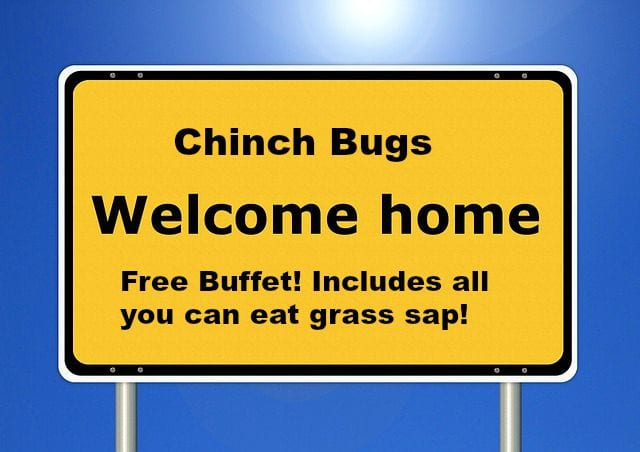

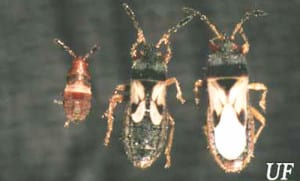
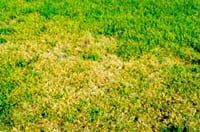
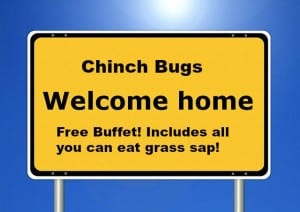
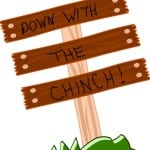
I had this issue last year. And I used this. How often should this be applied . Better stated can it be used as preventive maintenance against these bugs?
Hi Bea,
Not sure which product you applied, but you should always follow the application instructions listed on the product label. Some products definitely call for a follow up application and some state that only one application is necessary. If you chose beneficial nematodes, you really can’t overdo applying them (the more the merrier).
As for yearly applications, chances are, if you had the problem with chinch bugs the year before, it most likely will find you again the following year, so it’s best to go ahead and treat for them this summer again. Keep up with fertilizing and watering (mornings only) to keep your turf healthy which is the best defense against pests and disease. Hope this helps, and good luck!